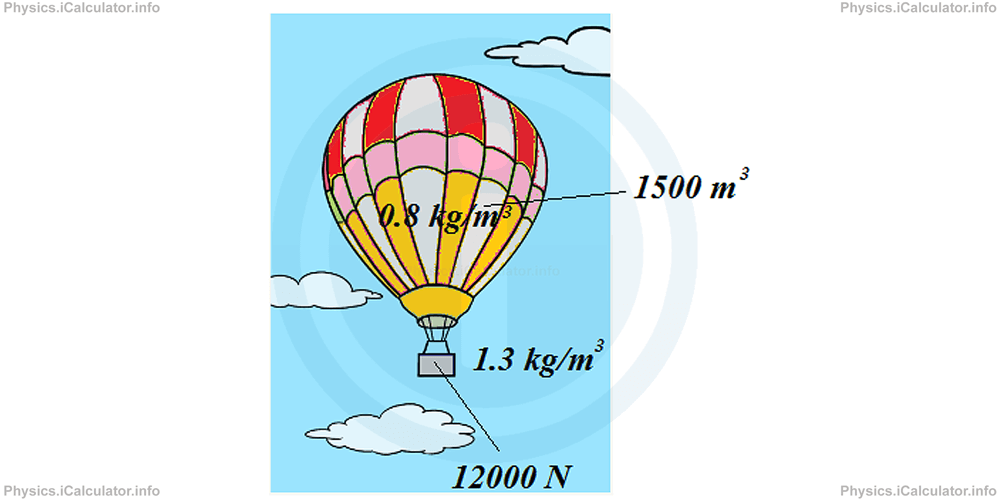Menu
Physics Lesson 9.5.4 - Buoyancy in Gases
Please provide a rating, it takes seconds and helps us to keep this resource free for all to use
Welcome to our Physics lesson on Buoyancy in Gases, this is the fourth lesson of our suite of physics lessons covering the topic of Buoyancy. Archimedes' Principle, you can find links to the other lessons within this tutorial and access additional physics learning resources below this lesson.
Buoyancy in Gases
We can say the same words for buoyancy in gases as well. The only difference is that in gases there is no floating; we consider the object completely immersed in gas (especially in air). The third case mentioned above when buoyancy in liquids was explain (i.e. when density of object is smaller than the density of gas), is discussed only to see whether the object is moving up or not. Thus, the three cases explained in the buoyancy of liquids adapted for buoyancy in gases are:
- When Fb < Wobject the object falls down on the ground. In this case, ρgas < ρobject
- When Fb = Wobject the object stays unmoveable, suspended in gas. In this case, ρgas = ρobject
- When Fb > Wobject the object rises up. In this case, ρgas > ρobject
Example 4
A balloon weighs 12 000 N when empty (all people and equipment are included in this value). When the balloon is flying, it has a volume of 1500 m3. What is happening with the balloon (is it rising up, saying unmoveable in air or falling down) if the balloon is filled with hot air (ρhot air = 0.8 kg/m3) and f the surrounding (cold) air has a density of 1.3 kg/m3? Take g = 10 m/s2.

Solution 4
The solution is simple. We must calculate the buoyant force caused by the cold air and compare it with the weight of empty balloon plus the weight of hot air inside the balloon. We have:
= 1.3 × 1500 × 10
= 19 500 N
Weight of the hot air inside the balloon is
= ρhot air × Vballoon × g
= 0.8 × 1500 × 10
= 12 000 N
Therefore, the total downward force is
= 12 000 N + 12 000 N
= 24 000 N
Since this force is greater than the buoyant force (lifting force) of the surrounding (cold) air, (24 000 N > 19 500 N), the balloon is falling down at 24 000 N - 19 500 N = 4500 N of resultant force.
You have reached the end of Physics lesson 9.5.4 Buoyancy in Gases. There are 4 lessons in this physics tutorial covering Buoyancy. Archimedes' Principle, you can access all the lessons from this tutorial below.
More Buoyancy. Archimedes' Principle Lessons and Learning Resources
Whats next?
Enjoy the "Buoyancy in Gases" physics lesson? People who liked the "Buoyancy. Archimedes' Principle lesson found the following resources useful:
- Gas Feedback. Helps other - Leave a rating for this gas (see below)
- Density and Pressure Physics tutorial: Buoyancy. Archimedes' Principle. Read the Buoyancy. Archimedes' Principle physics tutorial and build your physics knowledge of Density and Pressure
- Density and Pressure Revision Notes: Buoyancy. Archimedes' Principle. Print the notes so you can revise the key points covered in the physics tutorial for Buoyancy. Archimedes' Principle
- Density and Pressure Practice Questions: Buoyancy. Archimedes' Principle. Test and improve your knowledge of Buoyancy. Archimedes' Principle with example questins and answers
- Check your calculations for Density and Pressure questions with our excellent Density and Pressure calculators which contain full equations and calculations clearly displayed line by line. See the Density and Pressure Calculators by iCalculator™ below.
- Continuing learning density and pressure - read our next physics tutorial: Bernoulli Equation
Help others Learning Physics just like you
Please provide a rating, it takes seconds and helps us to keep this resource free for all to use
We hope you found this Physics lesson "Buoyancy. Archimedes' Principle" useful. If you did it would be great if you could spare the time to rate this physics lesson (simply click on the number of stars that match your assessment of this physics learning aide) and/or share on social media, this helps us identify popular tutorials and calculators and expand our free learning resources to support our users around the world have free access to expand their knowledge of physics and other disciplines.